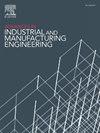高强度钢堆焊:多次加热热影响区的性能
IF 6
Q2 ENGINEERING, INDUSTRIAL
Advances in Industrial and Manufacturing Engineering
Pub Date : 2025-09-17
DOI:10.1016/j.aime.2025.100172
引用次数: 0
摘要
使用高强度钢作为堆焊的基础材料正变得越来越重要,特别是在经常受到动态载荷的应用中(例如,拆卸剪)。表面焊件的热影响区比传统焊接接头的热影响区复杂得多。相邻堆焊层导致热影响区亚区形成,这些区域经历了多次热循环,而这些区域以前没有被彻底研究过。高强钢对热循环更为敏感,热影响区分区的性能从根本上决定了硬面件的承载能力。本研究采用S690QL、S960QL和S1100QL基材。硬度测试确定经受三次热循环的亚区是最关键的。使用Gleeble物理模拟器通过施加三个连续的热循环来重现这些特定的亚层。对模拟试样进行了仪器冲击试验,并对试验结果进行了统计分析。同时进行了断口分析,通过定量评价揭示了断裂试样之间的明显差异。对于S690QL,关键分区的冲击性能没有明显变化。相比之下,对于S960QL,暴露于三个热循环的亚区显示出提高的冲击能量和降低的冲击力。令人惊讶的是,S1100QL的热影响区表现出的冲击能比基材高3倍以上。这些结果清楚地表明,经过三次热循环的亚区更柔软,但其冲击性能等于或优于基材。本文章由计算机程序翻译,如有差异,请以英文原文为准。
Hardfacing on high-strength steels: Properties of multiple times heated heat-affected zones
The use of high-strength steels as base materials for hardfacing is becoming increasingly important, particularly in applications subjected to frequent dynamic loads (e.g., demolition shears). The heat-affected zone (HAZ) of hardfaced components is significantly more complex than that in conventional welded joints. Adjacent hardfacing layers lead to the formation of HAZ subzones that undergo multiple thermal cycles, and these zones have not been thoroughly investigated before. High-strength steels are more sensitive to thermal cycles, and the properties of the HAZ subzones fundamentally determine the load-bearing capacity of hardfaced parts. In this study, S690QL, S960QL, and S1100QL base materials were used. Hardness testing identified the subzones subjected to three thermal cycles as the most critical. These specific subzones were reproduced using a Gleeble physical simulator by applying three successive thermal cycles. Instrumented impact tests were performed on the simulated specimens, and the results were analyzed statistically. Fractographic analysis was also conducted, revealing clear differences between fractured specimens through quantitative evaluation. For S690QL, the impact properties of the critical subzones did not show significant changes. In contrast, for S960QL, the subzones exposed to three thermal cycles demonstrated improved impact energy with reduced impact force. Surprisingly, the HAZ subzones of S1100QL exhibited impact energies more than three times higher than those of the base material. These results clearly indicate that the subzones subjected to three thermal cycles are softer, yet their impact properties are equal to or better than those of the base material.
求助全文
通过发布文献求助,成功后即可免费获取论文全文。
去求助
来源期刊

Advances in Industrial and Manufacturing Engineering
Engineering-Engineering (miscellaneous)
CiteScore
6.60
自引率
0.00%
发文量
31
审稿时长
18 days
 求助内容:
求助内容: 应助结果提醒方式:
应助结果提醒方式:


